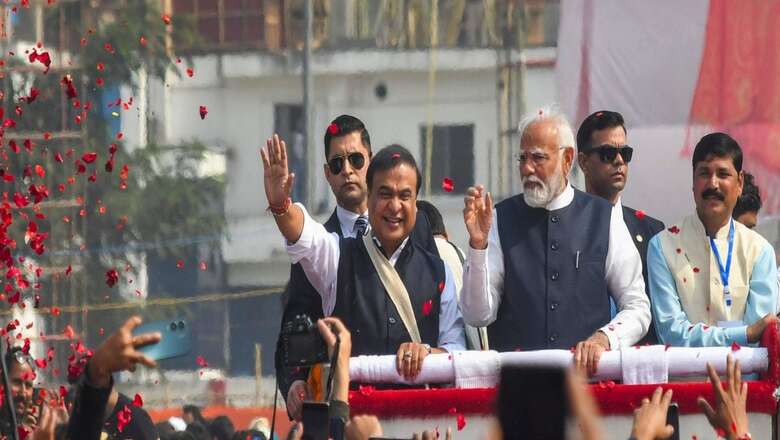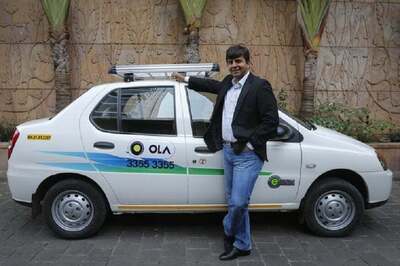
views
The state of Assam is geo-strategically located as the gateway to the Northeast and also shares two international boundaries, i.e. with Bhutan and Bangladesh. Assam which remained for decades, post-independence, under the grip of terror, militancy, agitation and underdevelopment, now sees a shining ray of new age development and all-round peace and progress under the ‘double engine’ government of the BJP.
It is worth mentioning here that a report of the Assocham in 2015 highlighted the poor infrastructure and limited connectivity due to the stringent policy measures of the government leading to industrial backwardness and unemployment. Now after almost 9 years of that report, with the change in government on both the levels (Union and state), Assam has excelled in all these parameters. The double-engine government led by the BJP is intensifying tremendous growth in infrastructure needs by creating new roads, inland waterways and other modes of transportation for efficient connectivity throughout the state which is crucial for the country’s Act East policy. The empirical causality between economic growth and road infrastructure is intrinsic and the incumbent policymakers are effectively engendering extensive government intervention in road infrastructure development to achieve higher sustainable economic growth as well as balanced development across the nation and the state of Assam.
Assam is developing faster than ever before under the double-engine government, and the report card will speak of this aloud. The report card justifies the BJP’s claim of faster growth and development, both at the Centre and the state level, to the maximum of planning, implementation, service delivery and a transparent good governance model. The federal metaphor of ‘double engine’ has transcended electoral brownie points. The government’s report card of goals and achievements proves it to be a powerful instrument for the reinvention of India’s cultural plurality, streamlined all-round development, inclusivity of the hitherto neglected underdeveloped regions and good governance. In the case of the BJP-ruled state of Assam, a successful collaboration with the Centre has resulted in more effective and coordinated policy implementation and service delivery.
Farce of Rahul Gandhi’s Nyay Yatra vis-a-vis Himanta Biswa Sarma’s March of Development
When the incumbent chief minister of Assam has been busy implementing an overarching model of growth and development and infrastructure creation under a double-engine model, Rahul Gandhi started his Bharat Jodo Nyay Yatra, where both terms ‘Bharat Jodo’ and ‘nyay’ are political rhetorics used to get political mileage. It’s BJP’s ‘practice’ vs Rahul Gandhi’s ‘precept’, regarding the term ‘nyay’ which has huge connotation related to re-distributive justice. Rahul Gandhi, the de-facto Congress head, toys with the party functioning according to his whims and fancies.
The Rahul Gandhi-led 6,500 km Manipur to Mumbai bus yatra, which the Congress has named as ‘Bharat Jodo Nyay Yatra’, will barely benefit it in the upcoming Lok Sabha polls in a situation where the ruling BJP is all set to return to power for the third consecutive term with the incumbent PM Narendra Modi as its Prime Ministerial candidate. In his Nyay Yatra, Rahul Gandhi, rather than meeting the Congress party workers and working at the grassroots level to strengthen the dying party, gasping for a new lease of life, has resorted to the propaganda of maligning the image of one of the most popular and successful regional leaders of the time, the incumbent chief minister of Assam, Himanta Biswa Sarma. Sarma, on the other hand, remains strong in his commitment to development and social justice, where the term ‘nyay’ actually fits better.
An Administrator with farsight and hindsight too
Before becoming the CM of Assam, Himanta Biswa Sarma held key ministries under the Chief Ministership of Sarbananda Sonowal and is credited with rolling out a series of development and welfare programmes, including the popular Orunodoi Scheme that provides Rs 8,000 each annually to unemployed women, which other Indian states have started implementing. Host of welfare schemes like Swanirbhar Nari – Atmanirbhar Asom Scheme, Kushal Konwar Briddha Pension Scheme, Aponar Apon Ghar Home Loan Scheme, Mukhya Mantri Lok Sevak Arogya Yojana, and Sarothi-The Start Up Assam are initiated and implemented with a vision of empowering the vulnerable section of society and also to encourage entrepreneurial skills among the youth. As the state finance minister, Himanta Biswa Sarma earned Assam the distinction of being the first state to roll out the GST regime (2016).
The trailblazing role of Sarma, the incumbent CM of Assam and the Convener of the North East Democratic Alliance (NEDA), is note-worthy. His style of functioning is that of a go-getter. Endowed with high administrative prudence, he has articulated peace, stability, agitation and bandh free Assam from unlawful killings and strove the state to a position of prominence in key parameters of growth and development. He has dealt with a lot of acumen with the BJP’s stand on contentious issues like the CAA and NRC or tapping into local sentiments accordingly. Inarguably, he is the man for the BJP in the region. His relentless electoral campaigns, post-poll political calculations and manoeuvring contributed highly to keeping the BJP in the region.
Not to forget that his political acumen and social capital was instrumental in forming the BJP government in Assam in 2016 (first term), followed by Arunachal Pradesh, Manipur and Tripura while the NDA held on to Nagaland, Mizoram and Meghalaya in a domino’s effect in the 2018 phase of Assembly elections and repeating the same in the case of 2023 Assembly polls in Tripura, Nagaland and Meghalaya. Despite Sarbananda Sonowal being the chief ministerial candidate of the BJP, Himanta Sarma was the main architect of the 2016 historic win over Assam and repeating the same in 2021. In 2021, Sarma became the chief minister of Assam. This divides the political vision of Amit Shah and the political miscalculations of Rahul Gandhi. The electoral debacle of the Congress in Assam only underscored the leadership’s inability to assess the political resourcefulness of an irreplaceable regional leader like Himanta Biswa Sarma, characterised by a combination of unfiltered knack for public dealing, administrative acumen, and political manoeuvring.
For his capabilities of an ‘indefatigable doer’, the BJP selected Himanta Biswa Sarma as the Convener of NEDA in 2016. And this decision can be regarded as the most prudent selection of a political mastermind for such a pivotal position. NEDA is a BJP-led front of anti-Congress parties in the Northeast which has been instrumental in aggressively wiping out the Congress from the region. India’s first-past-the-post electoral system results in highly intense, mathematically driven political strategising. BJP domination in Assam has been telling in both the last Parliamentary and Assembly polls in 2019, 2016 and 2021 respectively. The voting patterns in the general elections of 2019 and the 2021 Assembly elections in Assam along with the last three Assembly polls in three Northeastern states, then Rajasthan, Madhya Pradesh and Chhattisgarh speak the message of the electorate clearly and loudly in favour of the BJP and PM Narendra Modi.
The Indian National Congress (INC) is facing political extinction and is at the crossroads of life and death. In 2014, the Congress won a hopeless figure of 44 seats and in the 2019 general elections, the party won only 52 seats out of 542, which constitutes a meagre 9.6 per cent seat sharing. Due to the party’s consistent political miscalculations and the Gandhi family’s misgivings, at least 460 leaders left the Congress between 2014 and 2022. Around 177 MPs/MLAs left the party during elections, while 222 electoral candidates left the Congress for other parties.
Coming to electoral performance, till now, since 2014, the Congress has lost 43 out of 48 Assembly polls. Since 1998, the Congress has had a low strike rate of 26 per cent. Of the total 20,847 Assembly seats contested since 1998, the party has won just 5,397 till the end of 2022, which further declined after their complete defeat in the last three Assembly elections in the Northeast, Rajasthan, Chattisgarh and Madhya Pradesh. And Rahul Gandhi’s choice of Manipur as the beginning of this mimic yatra is baffling as the Gandhi scion just wants to capitalise on the Manipur violence for his political gain.
Assam’s Growth Model under the incumbent regime
Assam is developing under the double-engine government, being a participant in the holistic and inclusive growth model. This model has led the Indian federation to grow as the fastest-growing major economy in the world and is expected to grow as one of the top economies over the next decade. Backed by robust democratic credentials and the rising middle-income group with an ever-enthusiastic youth population, India is successfully adopting and implementing a social market economy strategy at a 6.5pc-7pc growth rate in FY23.
Infrastructure creation is one of the most important aspects of the Modi government. Increased capital expenditure (CapEx) positively impacts the national income through the multiplier effect (in India, the value of the multiplier is around 2.45), which refers to the change in the final income generated by a change in initial spending. It means if the CapEx is around Rs 1,000, then national income will grow by Rs 2,400.
In the latest Union Budget, the Centre increased revenue expenditure by only 1.5 per cent, while capital expenditure rose by 38 per cent. More than Rs 10 trillion has been allocated for infrastructure development. In the last nine years of the Modi government, the length of national highways has increased by more than 100 per cent.
PM Narendra Modi rolled out development projects worth Rs 11,600 crore in Assam on February 4, 2024. Of the announced infrastructure projects, some are funded by the state government and some by the Centre. Some of the major projects for which foundation stones were laid were the Kamakhya temple corridor (Rs 498 crore), the six-lane road from the new airport terminal in Guwahati (Rs 358 crore), the upgradation of Nehru Stadium to FIFA standards (Rs 831 crore) and a new sports complex in Chandrapur (Rs 300 crore).
Five infrastructure projects of roads and railways have been recommended for approval under the PM GatiShakti initiative. These projects were assessed in the 65th Network Planning Group (NPG) meeting which was held on December 7, 2023. The PM GatiShakti was launched by Narendra Modi on the 75th Independence Day (2021). As per GatiShakti principles, the projects were discussed to promote multimodal connectivity to the manufacturing and commercial zones, while uplifting the socioeconomic development of the region through an improved logistics ecosystem. This initiative will subsume various infrastructure projects like the Bharatmala, Sagarmala, inland waterways dry/land ports, UDAN etc. Under the programme, 100 critical gap projects have been prioritised in FY24 for development with a budgetary allocation of 75,000 crore.
The second road project of the Gatishakti initiative is situated in Assam and Mizoram and offers an alternative connectivity route in the region, resulting in a 20 per cent reduction in length (from 215 km to 172 km) and a 50 per cent reduction in travel time (from 5 hours to 2.5 hours) over present connectivity. This road is poised to benefit industrial parks and the Bamboo Technology Park in the region. The Assam Cabinet on February 2, 2022, had approved setting up a high-level task force to oversee the “proper implementation of PM GatiShakti” project.
With an initial allocation of Rs 1,500 crore, the Union budget 2022-23 proposed to roll out the Prime Minister’s Development Initiative for North East Region (PM-DevINE). This is expected to fill vital gaps in infrastructure development and generate livelihood activities for youth and women. It will fund infrastructure, in the spirit of PM GatiShakti, and social development projects based on the needs of the Northeast. This will enable livelihood activities for youth and women, filling the gaps in various sectors. The projects include the establishment of dedicated services for the management of paediatric and adult hematolymphoid cancers in Northeast India, Guwahati (Multi-State) with Rs 129 crore, and NECTAR Livelihood Improvement Project (Multi-State) Rs 67 crore.
The Union Minister for Road Transport and Highways, Nitin Gadkari, inaugurated in June 2023, four infrastructure projects worth Rs 1450 in Assam. The projects include a four-lane section between Nagaon Bypass-Teliagaon and Teliagaon-Rangagara, a 15 km bypass in Mangaldai, and a 13 km bypass between Daboka and Parakhuwa. The four-lane section between Nagaon Bypass-Teliagaon and Teliagaon-Rangagara is 18 km long and will cost Rs 403 crore. The bypass will improve connectivity between North Assam and Upper Assam and is expected to boost economic growth and create new opportunities in the region.
The Assam Urban Infrastructure Investment Program (AUIIP), is an Externally Aided Project (EAP) and is a key urban infrastructure initiative of the Government of Assam (GoA), which aims to improve the urban environment and quality of life in the cities of Guwahati and Dibrugarh. The Department of Housing and Urban Affairs (DoHUA) is the executive agency (EA) for the projects under AUIIP.
The AUIIP phase-I was funded by the Asian Development Bank (ADB) through its Multi Tranche Financing Facility (MFF) for a period of 10 years during 2011-2021. The Tranche-1 loan was signed on March 8, 2012, and the Tranche-2 loan was signed on March 9, 2019. Both Tranche 1 and 2 loans were closed on September 30, 2021. The total MFF loan amount was $72.29 million. The AUIIP phase-II was posed to the New Development Bank (NDB) by the Department of Economic Affairs (DEA), Government of India on March 16, 2021, for funding up to $83.09 million after approval of the Preliminary Project Report (PPR) for AUIIP phase-II by the Screening Committee of DEA in its 115th Meeting held on February 26, 2021. The Multitranche Financing Facility will finance a slice of the government’s investment plan for Assam’s urban sector through the Assam Urban Infrastructure Investment Program. It will improve the urban services in these cities by improving water supply, sanitation, solid waste management (SWM), and drainage infrastructure to the standards set by the state.
In a significant move towards bolstering infrastructure development in Assam, the Chief Minister’s Office has unveiled plans to channelise resources through the North East Special Infrastructure Development Scheme (NESIDS). This special scheme, operating under the Ministry of Development of North Eastern Region (DoNER), is designed to address critical infrastructure needs, with a particular focus on road development. Assam has been allocated a substantial budget of Rs 666 crore under NESIDS (Roads) for the period 2022-26. Four key road projects have received approval from the Ministry of DoNER under NESIDS (Roads).
Furthermore, another five projects under NESIDS (other than roads and infrastructure) are currently under consideration at various stages by the Ministry of DoNER. Promoting scientific Organic Agriculture in Northeast India (Multi-State) with an approved cost of Rs 45 crore, construction of Aizawl Bypass on Western Side for Rs 500 crore, besides gap funding for Passenger Ropeway System for Pelling to Sanga-Choeling in West Sikkim for Rs 64 crore are other initiatives.
Health services receive fresh boost
Health services under Himanta Biswa Sarma have earned laurels of excellence. Assam under his aegis as the incumbent Health Minister has faced the Covid-19 waves with exceptional infrastructural preparedness. At present, there are 12 medical colleges in Assam. The government is undertaking the construction of nine more medical colleges. By 2026-27, Assam will have 21 medical colleges, as per an official statement by the CM in 2023. Assam also has an AIIMS near Guwahati. A host of welfare schemes related to health services have been launched and successfully implemented by the current regime under the chief ministership of Himanta Biswa Sarma. Some of the schemes are Pradhan Mantri Surakshit Mtritva Abhiyan, Operation Smile, Free Drugs Service, Shishu Suraksha Karyakram, Janani Suraksha Yojana, Mrityunjoy-108 ambulance Service, Rashtriya Baal Suraksha Karyakram etc.
All round peace and prosperity in the state has been possible due to Sarma working and acting in complete synergy with the Union government under the Prime Ministership of Narendra Modi. Himanta Biswa Sarma’s tenure as the Chief Minister of Assam has bore fruits to lead the state to a new direction of peace, inclusivity, development, transparency and good governance. A conscientious citizen-centric model of good governance is the key to Himanta Biswa Sarma’s success as a leader and an administrator.
The author is a senior faculty in the Department of History, ARSD College, University of Delhi. Views expressed in the above piece are personal and solely that of the author. They do not necessarily reflect News18’s views.




















Comments
0 comment